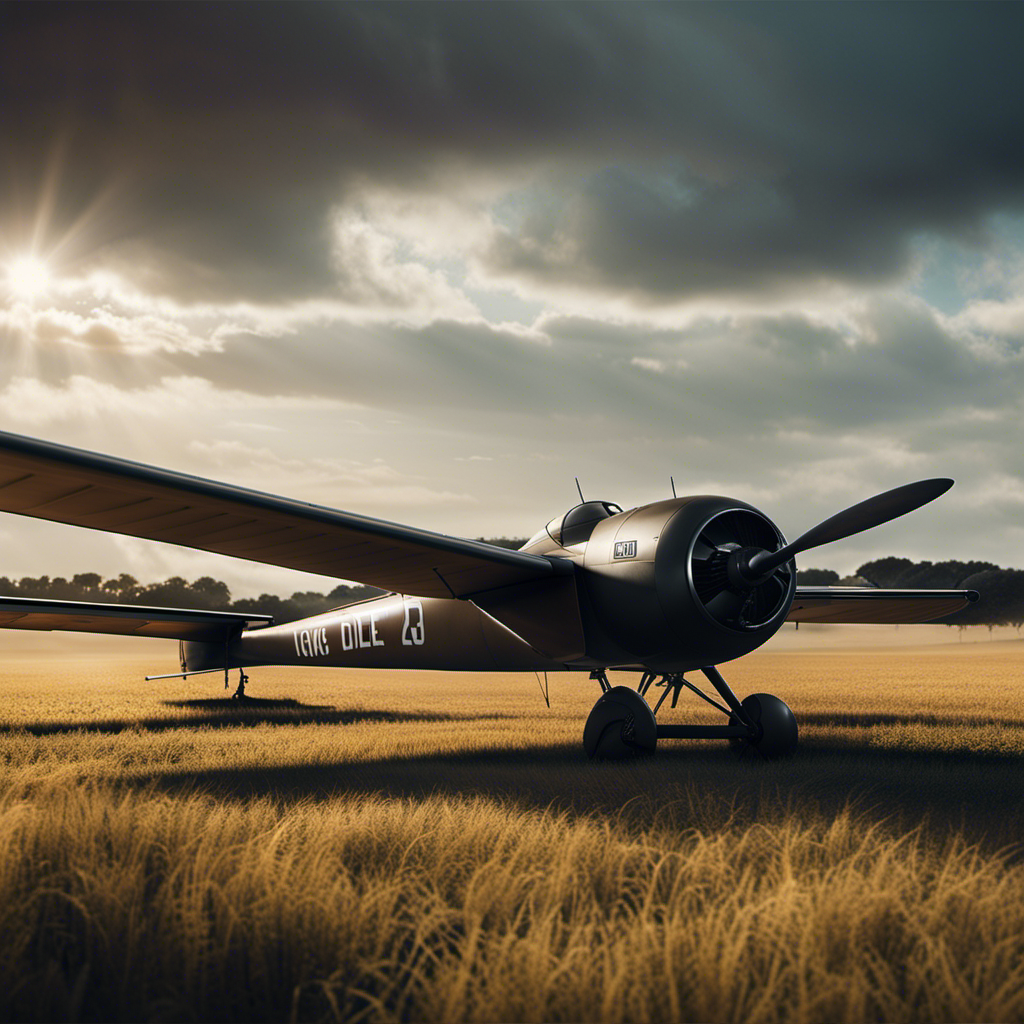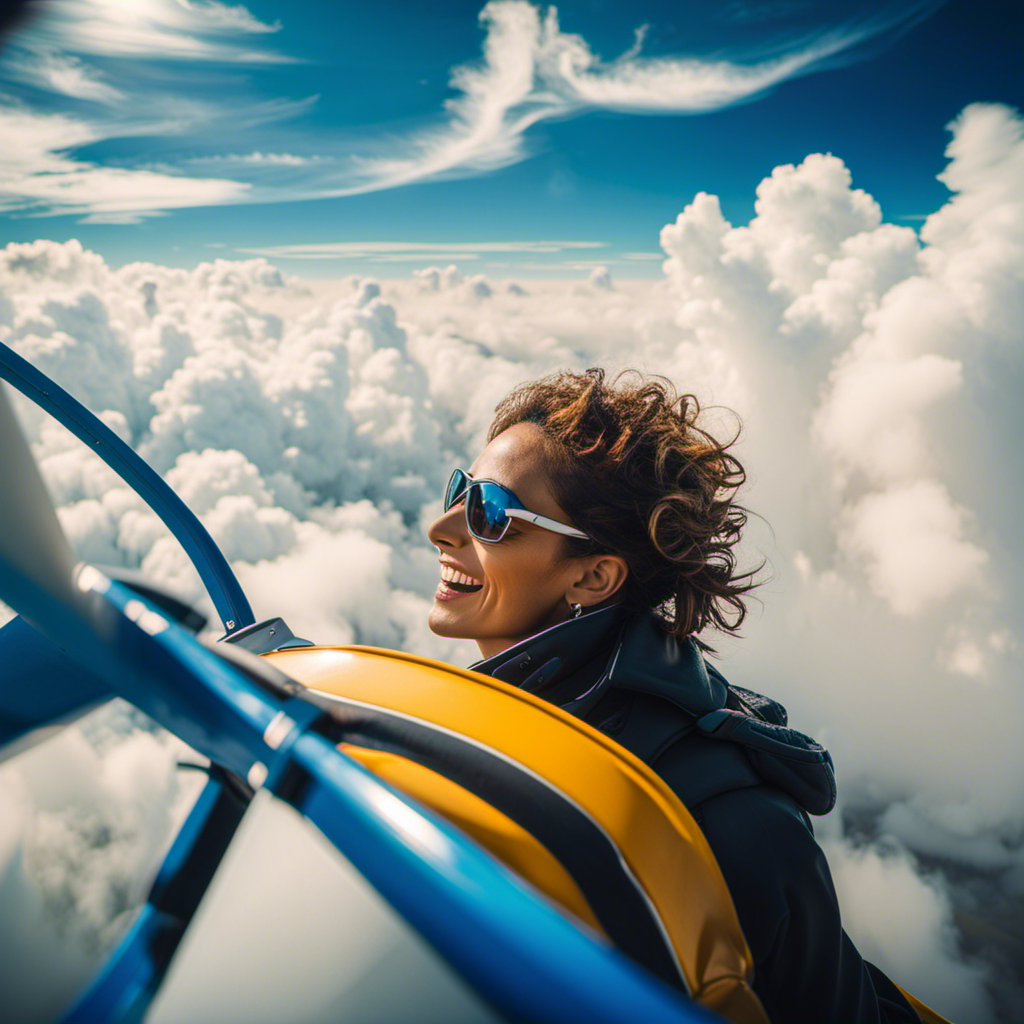I have always firmly believed that safety should be the top priority in all aviation activities. That is why I am excited to share this comprehensive guide on glider parachutes with you.
In this article, we’ll explore the different types of glider parachutes, how to properly use and maintain them, and the important safety considerations to keep in mind.
We’ll also discuss emergency descent techniques, the significance of regular training, and the legal and regulatory requirements.
So let’s dive in and ensure a safe gliding experience together.
Key Takeaways
- There are two types of glider parachutes: round parachutes for beginners and ram-air parachutes for advanced users.
- Proper usage and technique involve thorough pre-flight checks, understanding deployment procedures, regular training, and following legal requirements.
- Regular maintenance and inspections are necessary to ensure optimal condition and functionality of the parachute.
- Emergency procedures and safety measures include staying calm, familiarizing oneself with emergency equipment and procedures, and knowing how to deploy the emergency parachute.
Types of Glider Parachutes
There are two main types of glider parachutes: the round parachute and the ram-air parachute. Each type has its own unique design and purpose.
The round parachute is the traditional style, characterized by its circular shape. It is simple and reliable, making it suitable for beginners.
On the other hand, the ram-air parachute is more advanced and offers greater maneuverability. It has a rectangular shape and uses air-filled cells to maintain its structure.
Both types require regular maintenance to ensure their proper functioning. A maintenance schedule should be followed to inspect and repair any damages or wear and tear.
This will ensure the parachutes are in optimal condition for use. Understanding the different types of glider parachutes and their maintenance requirements is crucial for their proper usage.
Proper Usage of Glider Parachutes
As a glider pilot, I understand the importance of properly utilizing glider parachutes. In order to ensure a safe flight, it is crucial to perform thorough pre-flight checks, including inspecting the parachute for any signs of wear or damage.
Additionally, understanding the correct deployment procedures and landing techniques is essential for successfully using a glider parachute in emergency scenarios. Regular training and practice enable pilots to confidently handle any unexpected situations that may arise during flight.
Pre-flight checks
Before you take off, make sure to perform all the necessary pre-flight checks on your glider parachute. Proper pre-flight preparation is crucial for ensuring the safety and effectiveness of your equipment.
Begin by conducting a thorough equipment inspection. Inspect the parachute for any signs of damage or wear, such as tears, frays, or loose stitching. Check the harness and straps for any signs of wear or weakness. Ensure that all buckles and fasteners are secure and functioning properly.
Additionally, inspect the reserve parachute to ensure it is properly packed and ready for deployment.
By meticulously performing these pre-flight checks, you can greatly reduce the risk of equipment failure during your flight.
Now, let’s move on to the deployment procedures.
Deployment procedures
To ensure a safe deployment, make sure to follow the proper procedures. Parachute packing and emergency deployment are critical aspects of glider safety.
When packing the parachute, it is essential to carefully inspect all components for any signs of damage or wear. The parachute should be neatly folded and secured in its container, ensuring that all straps and connections are correctly fastened.
During an emergency deployment, it is crucial to remain calm and act quickly. Pull the deployment handle firmly and with a steady motion, allowing the parachute to deploy smoothly. Once the parachute is fully deployed, maintain control of the glider and prepare for landing.
Transitioning into the subsequent section about landing techniques, it is important to consider the proper techniques for a safe touchdown.
Landing techniques
Remember, when landing, keep your body relaxed and your eyes focused on the landing spot ahead. Landing techniques are crucial for a safe and successful emergency landing. Here are four key techniques to master:
-
Approach: Maintain a steady descent rate and keep the glider aligned with the landing spot. Adjust speed and altitude as needed.
-
Flare: As you reach the ground, gently flare the glider to slow down and reduce vertical speed. This will ensure a soft touchdown.
-
Legs: Extend your legs just before touchdown to absorb the impact and maintain balance. Bend your knees upon landing to further cushion the landing.
-
Rollout: After landing, maintain control of the glider and smoothly transition into the rollout phase. Keep the wings level and use the brakes to slow down.
By mastering these landing techniques, you increase your chances of a safe and controlled emergency landing.
Now let’s explore how to handle different emergency scenarios without compromising safety.
Emergency scenarios
During emergency scenarios, it’s important to stay calm and assess the situation before taking any action. Having a clear understanding of emergency procedures and being well-equipped with emergency equipment is crucial when it comes to gliding. In the event of an emergency, knowing what steps to take can make all the difference.
This includes knowing how to deploy the emergency parachute, which is a vital piece of equipment that can save your life in critical situations. It’s important to familiarize yourself with the location and operation of emergency equipment, such as the emergency radio and first aid kit. By being prepared and knowledgeable, you can effectively handle emergency situations while gliding.
Transitioning into the next section about ‘training and practice’, it’s essential to regularly practice emergency procedures to ensure readiness in real-life scenarios.
Training and practice
During emergency scenarios, it is crucial to have the necessary skills and knowledge to react quickly and effectively. However, simply knowing what to do is not enough; practice makes perfect. That’s why training and practice are integral parts of glider parachute safety.
By engaging in regular training exercises and safety drills, we can enhance our response time and decision-making abilities in high-stress situations. Here are three essential training exercises to keep in mind:
-
Mock emergency landings: Simulating emergency landings allows us to practice our landing techniques and develop muscle memory for a smooth and safe touchdown.
-
Emergency equipment drills: Regularly going through the motions of deploying emergency equipment, such as the reserve parachute, ensures that we are familiar with the process and can execute it correctly when needed.
-
Emergency procedures review: Regularly reviewing emergency procedures helps us stay updated on best practices and reinforces our knowledge of how to handle different scenarios.
By diligently engaging in training exercises and safety drills, we can better prepare ourselves for any unforeseen circumstances that may arise during glider parachute operations.
Now, let’s transition to the subsequent section about maintenance and inspection.
Maintenance and Inspection
When it comes to maintaining and inspecting glider parachutes, there are several key points to consider.
Regular inspections are crucial to ensure the parachute is in optimal condition. It is important to replace any worn or damaged parts promptly to maintain the safety and functionality of the parachute.
Additionally, proper storage, cleaning, and maintenance procedures should be followed to prolong the lifespan of the parachute.
Service intervals and professional inspections should also be scheduled to thoroughly assess the condition of the parachute and address any potential issues.
Regular inspections
Regular inspections are essential to ensure the safety of the glider parachute. By conducting regular inspections, we can identify any potential issues or defects that may compromise the performance and reliability of the equipment. These inspections are a crucial step in preventing accidents and ensuring the longevity of the parachute. During the inspection process, various components of the parachute are thoroughly examined, including the canopy, lines, harness, and deployment system. Any signs of wear, damage, or malfunction are noted, and appropriate action is taken to address them. To give you a clearer picture, here is a table that outlines the key elements inspected during a regular inspection:
| Component | Inspection Procedure |
|---|---|
| Canopy | Visual inspection for tears, holes, or abrasions |
| Lines | Check for fraying, knot integrity, and tension |
| Harness | Inspect for any signs of wear or damage |
| Deployment System | Verify proper functioning and alignment |
| Hardware | Examine for corrosion or damage |
Replacement of worn or damaged parts
To ensure optimal performance and prevent accidents, it’s important for you to promptly replace any worn or damaged parts of your equipment. Glider parachutes are complex systems that rely on the proper functioning of each component to ensure a safe descent.
When conducting regular inspections, it’s crucial to identify any signs of wear or damage, such as frayed ropes, torn fabric, or broken buckles. Once these issues are identified, it’s essential to follow proper repair techniques or replace the damaged parts entirely. This may involve sewing patches, replacing ropes, or installing new buckles.
By addressing these issues promptly, you can maintain the integrity of your glider parachute and ensure its reliable performance during each jump.
Now, let’s move on to the next section, which covers the proper storage of your equipment.
Proper storage
During my years of experience with glider parachutes, I’ve come to understand the importance of proper storage. Here are some key points to consider:
-
Store your glider parachute in a clean, dry, and well-ventilated area. This prevents moisture buildup and potential damage.
-
Hang the parachute in a designated storage bag or container. This protects it from dust, dirt, and insects.
-
Avoid exposing the parachute to direct sunlight or extreme temperatures. These can degrade the materials over time.
-
Regularly inspect the storage area and the parachute for any signs of damage, such as tears, fraying, or mold.
Proper storage is just one aspect of maintaining a glider parachute. In the next section, we’ll delve into the cleaning and maintenance procedures necessary to keep your equipment in optimal condition.
Cleaning and maintenance procedures
Make sure you regularly inspect and clean your equipment to maintain its functionality and ensure your safety. Proper cleaning procedures are essential for the longevity and performance of your glider parachute.
Begin by removing any debris or dirt from the canopy and lines using a soft brush or cloth. Pay close attention to the stitching and seams, ensuring they are free from any damage or wear.
It is also important to adhere to a maintenance schedule, which includes regularly checking the harness, risers, and hardware for any signs of wear or corrosion.
By following these cleaning procedures and maintaining a regular maintenance schedule, you can ensure that your glider parachute remains in optimal condition. However, it is important to note that regular cleaning and maintenance should be supplemented with service intervals and professional inspections to guarantee the highest level of safety.
Transitioning into the subsequent section about service intervals and professional inspections, it is crucial to understand that routine maintenance alone may not be sufficient to identify hidden issues or potential safety concerns.
Service intervals and professional inspections
Regular inspections and professional service are necessary to ensure the ongoing safety and performance of your equipment. Adhering to recommended service intervals is crucial in maintaining the reliability and functionality of your glider parachute.
Professional inspections should be conducted by qualified technicians who possess the expertise to identify potential issues and ensure compliance with safety standards. These inspections involve a thorough examination of all components, including the canopy, harness, and deployment system.
During the inspection, any worn or damaged parts will be identified and replaced to prevent any potential malfunctions during use. By following a regular service schedule and entrusting your equipment to professionals, you can have peace of mind knowing that your glider parachute is in optimal condition.
This ensures that you can enjoy your gliding adventures while prioritizing your safety.
Safety Considerations
It’s important to always check the weather conditions before using a glider parachute. This ensures that you are aware of any potential hazards or unsafe conditions that could affect your flight. In addition to checking the weather, it is crucial to familiarize yourself with the emergency procedures and safety equipment of your glider parachute. Being prepared for an emergency situation can mean the difference between life and death. Here is a table outlining some key safety equipment and emergency procedures:
| Safety Equipment | Emergency Procedures |
|---|---|
| Parachute | Emergency deployment |
| Helmet | Emergency descent |
| Harness | Emergency landing |
Emergency Descent Techniques
Knowing how to perform emergency descent techniques is crucial for every pilot using a glider parachute. In emergency scenarios where a rapid descent is necessary, these techniques can save lives.
Here are three essential emergency descent techniques to master:
-
The spiral dive: By entering a controlled spiral dive, the pilot can quickly lose altitude while maintaining control of the glider. This technique should only be used in emergencies, as it can be disorienting and put stress on the glider.
-
The vertical dive: This technique involves diving straight down to rapidly lose altitude. Pilots must be cautious when performing this maneuver to avoid exceeding the glider’s maximum speed.
-
The wing-over descent: This technique combines a series of coordinated turns with a dive, allowing the pilot to descend rapidly while maintaining control and stability.
Mastering these emergency descent techniques is essential for a glider pilot’s safety. However, it is important to remember that these techniques should only be used in emergency situations, as they carry inherent risks.
In the next section, we will discuss the risks and safety precautions associated with emergency descents.
Risks and Safety Precautions
After discussing emergency descent techniques, it is crucial to shift our focus to the risks associated with glider parachuting and the safety precautions that must be taken.
Risk assessment plays a fundamental role in ensuring a safe glider parachute experience. It involves identifying potential hazards, evaluating their likelihood and severity, and implementing appropriate measures to mitigate them.
Safety equipment, such as helmets, harnesses, and reserve parachutes, are essential for protecting the skydiver in case of emergencies. These equipment should be regularly inspected and maintained to ensure their effectiveness. Additionally, training in the proper use of safety equipment is vital to maximize their potential benefits.
Without regular training, one may not be able to respond effectively during critical situations, jeopardizing their safety. Thus, in the subsequent section, we will discuss the importance of regular training in glider parachute operations.
The Importance of Regular Training
Regular training is crucial for maintaining proficiency and ensuring optimal performance in glider parachute operations. As a glider parachute operator, I understand the importance of ongoing education and staying up to date with the latest techniques and safety protocols.
Regular training not only helps me refine my skills but also keeps me aware of any changes in regulations or best practices. Through ongoing training, I am able to enhance my decision-making abilities, improve my situational awareness, and effectively handle emergency situations.
It allows me to stay confident and competent in executing glider parachute operations, ensuring the safety of myself and others. By consistently honing my skills through regular training, I can meet the legal and regulatory requirements in the field without any compromise in safety.
Legal and Regulatory Requirements
As a glider parachute operator, it’s essential to stay informed about the current legal and regulatory requirements that govern our operations. Ensuring regulatory compliance is crucial to maintaining safety and preventing any legal issues that may arise.
The legal requirements for glider parachute operations cover various aspects, including pilot certifications, aircraft maintenance, and airspace regulations. It is necessary to be familiar with the specific regulations set forth by the Federal Aviation Administration (FAA) and any local authorities.
Regularly reviewing and updating our procedures and practices in accordance with these legal requirements is vital to running a safe and compliant operation. By staying up-to-date and adhering to these regulations, we can ensure the safety of our crew and passengers.
Transitioning into the subsequent section, it is also important to utilize safety resources and organizations to further enhance our operations.
Safety Resources and Organizations
You can benefit from utilizing various resources and organizations dedicated to enhancing the safety of glider parachute operations. Safety education is crucial in preventing accidents and ensuring the well-being of both pilots and passengers. In the event of an incident, thorough accident investigation is necessary to learn from mistakes and prevent similar occurrences in the future. The table below provides a list of some valuable resources and organizations that can assist in promoting safety within the glider parachute community:
| Resource/Organization | Description |
|---|---|
| Federal Aviation Administration (FAA) | Provides regulations, guidelines, and safety information for glider parachute operations. |
| Glider Pilot’s Association (GPA) | Offers safety courses, seminars, and publications to educate glider pilots on best practices. |
| National Transportation Safety Board (NTSB) | Conducts accident investigations and provides safety recommendations to prevent future incidents. |
| International Gliding Commission (IGC) | Promotes safety by developing international standards and guidelines for gliding activities. |
| Local Gliding Clubs | Provide safety briefings, mentorship programs, and access to experienced glider pilots. |
Conclusion and Final Thoughts
As a glider pilot, it is crucial to prioritize safety in every aspect of our flying. This means continually seeking ways to improve our skills and knowledge through ongoing learning.
Safety is not just the responsibility of a select few, but rather it is the duty of every glider pilot to ensure the safety of themselves and others.
Importance of prioritizing safety
Make sure to always prioritize safety when using a glider parachute. Safety should be the cornerstone of any activity involving glider parachutes. It is crucial to establish a strong safety culture and promote safety awareness among all participants.
Here are some key points to consider:
- Regularly conduct safety briefings to educate participants on proper procedures and potential risks.
- Emphasize the importance of pre-flight inspections to ensure that all equipment is in optimal condition.
- Encourage the use of appropriate safety gear, such as helmets and harnesses, to minimize the risk of injury.
- Implement clear communication protocols to enhance coordination and reduce the chances of accidents.
- Regularly review and update safety guidelines to stay current with industry standards and best practices.
By adhering to these safety measures, we can create an environment that prioritizes the well-being of all individuals involved in glider parachute activities.
The next section will delve into the concept of continual improvement and learning in relation to glider parachute safety.
Continual improvement and learning
As a glider pilot, the importance of prioritizing safety is always at the forefront of my mind. However, ensuring safety is not a static goal; it requires continual improvement and lifelong learning.
In the world of aviation, new techniques, technologies, and information are constantly emerging, and it is our responsibility as pilots to stay updated and adapt accordingly. By embracing a mindset of continual improvement, we can enhance our knowledge, skills, and decision-making abilities, ultimately minimizing risks and maximizing safety.
Lifelong learning is not just a requirement; it is a mindset that allows us to grow and evolve as pilots. It involves seeking out new training opportunities, staying informed about industry developments, and engaging in regular self-assessment.
Safety as a responsibility of all glider pilots
You have a crucial responsibility as a glider pilot to prioritize the well-being of yourself and others. Safety is of utmost importance in the world of gliding, and as pilots, we must be diligent in managing risks and following proper safety procedures.
Here are four key aspects of risk management and safety procedures that every glider pilot should keep in mind:
- Pre-flight Planning: Thoroughly assess weather conditions, airspace restrictions, and potential hazards before taking off.
- Equipment Maintenance: Regularly inspect and maintain your glider to ensure it is in optimal condition for safe flying.
- Emergency Preparedness: Familiarize yourself with emergency procedures and practice them regularly to be prepared for any unforeseen situations.
- Constant Vigilance: Stay alert during every phase of flight, actively scanning for other aircraft, monitoring instruments, and adjusting your flight path as necessary.
Encouraging a safety culture in the gliding community
To foster a culture of safety in the gliding community, it is essential for all pilots to prioritize risk management and adhere to proper safety procedures. Encouraging safety awareness and promoting safety education are key aspects of building this culture.
By actively engaging pilots in discussions and workshops focused on safety, we can instill a sense of responsibility and vigilance when it comes to flying. One effective way to promote safety education is through the use of comprehensive training programs that cover topics such as emergency procedures, weather analysis, and aircraft maintenance. These programs should be regularly updated to incorporate the latest industry standards and best practices.
Safe and enjoyable glider flying experiences
Creating a culture of safety within the gliding community enhances the overall flying experience by ensuring that pilots can enjoy their time in the air with peace of mind.
It is crucial for glider pilots to have access to safety equipment, such as a glider parachute, which can be a lifesaver in emergency situations. Understanding the proper deployment techniques is essential for effective parachute use. Here are three key points to consider:
-
Safety equipment: Glider parachutes are designed to provide an additional layer of protection in case of an emergency. They are lightweight and compact, making them easy to carry on board.
-
Parachute deployment techniques: Pilots must be trained in the correct procedures for deploying a glider parachute. This includes knowing when and how to initiate the deployment process, as well as proper body positioning to ensure a successful landing.
-
Regular maintenance and inspection: Glider parachutes should undergo regular maintenance and inspection to ensure their functionality. This includes checking for any signs of wear and tear, replacing any damaged components, and repacking the parachute according to manufacturer guidelines.
Frequently Asked Questions
Are glider parachutes reusable, or do they need to be replaced after each use?
Glider parachutes are reusable but need to be inspected and repacked after each use to ensure their functionality and safety. Regular maintenance and replacement of worn-out parts are essential to maintain the parachute’s reliability.
How long does it typically take to deploy a glider parachute in an emergency situation?
Deploying a glider parachute in an emergency is a race against time. With practice, it becomes second nature. The glider parachute deployment time can vary, but proper emergency procedures ensure swift and efficient action.
Can glider parachutes be used in all types of weather conditions?
Glider parachutes can be used in various weather conditions, but certain factors must be considered. Advantages include their ability to provide a controlled descent, while disadvantages include potential complications during high wind or turbulent weather.
Are there any weight restrictions for using a glider parachute?
Are there any weight restrictions for using a glider parachute? Glider parachute weight restrictions and limits are crucial for ensuring safe operation. Understanding these limitations is essential for a successful and secure gliding experience.
Do glider parachutes require any special storage or care when not in use?
When not in use, glider parachutes require special storage and care requirements. This ensures their longevity and functionality. Properly storing the parachute in a dry, cool place and regularly inspecting it are essential for its optimal performance and safety.
Conclusion
Well, that concludes our thorough and technical guide to glider parachutes. Remember, safety is of utmost importance when it comes to any aviation activity.
So, it’s ironic that despite all the precautions and training we’ve discussed, accidents can still happen. But fear not! By following the proper usage guidelines, performing regular maintenance and inspections, and staying up to date with legal requirements, you’ll significantly reduce the risks.
Stay safe up there, and happy gliding!









